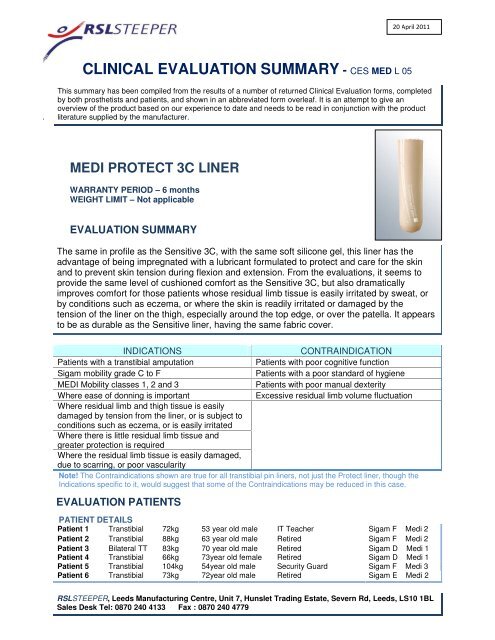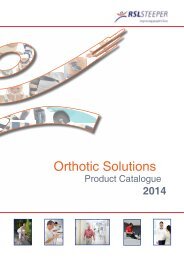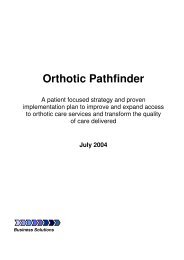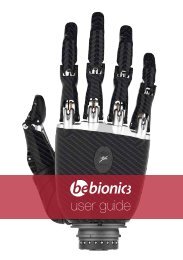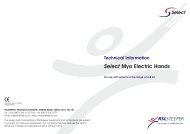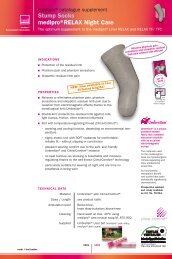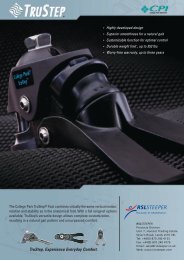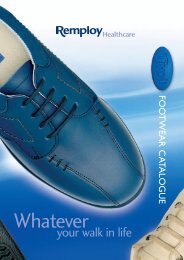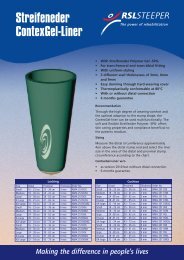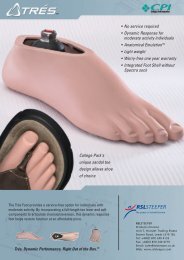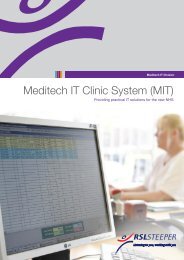Medi Protect 3C Liner Clinical Evaluation Summary - R S L Steeper
Medi Protect 3C Liner Clinical Evaluation Summary - R S L Steeper
Medi Protect 3C Liner Clinical Evaluation Summary - R S L Steeper
Create successful ePaper yourself
Turn your PDF publications into a flip-book with our unique Google optimized e-Paper software.
20 April 2011<br />
CLINICAL EVALUATION SUMMARY - CES MED L 05<br />
.<br />
This summary has been compiled from the results of a number of returned <strong>Clinical</strong> <strong>Evaluation</strong> forms, completed<br />
by both prosthetists and patients, and shown in an abbreviated form overleaf. It is an attempt to give an<br />
overview of the product based on our experience to date and needs to be read in conjunction with the product<br />
literature supplied by the manufacturer.<br />
MEDI PROTECT <strong>3C</strong> LINER<br />
WARRANTY PERIOD – 6 months<br />
WEIGHT LIMIT – Not applicable<br />
EVALUATION SUMMARY<br />
The same in profile as the Sensitive <strong>3C</strong>, with the same soft silicone gel, this liner has the<br />
advantage of being impregnated with a lubricant formulated to protect and care for the skin<br />
and to prevent skin tension during flexion and extension. From the evaluations, it seems to<br />
provide the same level of cushioned comfort as the Sensitive <strong>3C</strong>, but also dramatically<br />
improves comfort for those patients whose residual limb tissue is easily irritated by sweat, or<br />
by conditions such as eczema, or where the skin is readily irritated or damaged by the<br />
tension of the liner on the thigh, especially around the top edge, or over the patella. It appears<br />
to be as durable as the Sensitive liner, having the same fabric cover.<br />
INDICATIONS<br />
CONTRAINDICATION<br />
Patients with a transtibial amputation<br />
Patients with poor cognitive function<br />
Sigam mobility grade C to F<br />
Patients with a poor standard of hygiene<br />
MEDI Mobility classes 1, 2 and 3<br />
Patients with poor manual dexterity<br />
Where ease of donning is important<br />
Excessive residual limb volume fluctuation<br />
Where residual limb and thigh tissue is easily<br />
damaged by tension from the liner, or is subject to<br />
conditions such as eczema, or is easily irritated<br />
Where there is little residual limb tissue and<br />
greater protection is required<br />
Where the residual limb tissue is easily damaged,<br />
due to scarring, or poor vascularity<br />
Note! The Contraindications shown are true for all transtibial pin liners, not just the <strong>Protect</strong> liner, though the<br />
Indications specific to it, would suggest that some of the Contraindications may be reduced in this case.<br />
EVALUATION PATIENTS<br />
PATIENT DETAILS<br />
Patient 1 Transtibial 72kg 53 year old male IT Teacher Sigam F <strong>Medi</strong> 2<br />
Patient 2 Transtibial 88kg 63 year old male Retired Sigam F <strong>Medi</strong> 2<br />
Patient 3 Bilateral TT 83kg 70 year old male Retired Sigam D <strong>Medi</strong> 1<br />
Patient 4 Transtibial 66kg 73year old female Retired Sigam D <strong>Medi</strong> 1<br />
Patient 5 Transtibial 104kg 54year old male Security Guard Sigam F <strong>Medi</strong> 3<br />
Patient 6 Transtibial 73kg 72year old male Retired Sigam E <strong>Medi</strong> 2<br />
RSLSTEEPER, Leeds Manufacturing Centre, Unit 7, Hunslet Trading Estate, Severn Rd, Leeds, LS10 1BL<br />
Sales Desk Tel: 0870 240 4133 Fax : 0870 240 4779
EVALUATION RESULTS<br />
CURRENT PRESCRIPTION<br />
Patient 1 Polypropylene socket with Blatchford’s shuttlelock, Otto Bock TEC pin liner and Multiflex foot<br />
Patient 2 Laminate socket with Icex pads and Icelock 600 ratchet lock, Iceross clear liner, Flexwalk foot<br />
Patient 3 Polypropylene socket with Blatchford’s shuttlelock and Multiflex foot, Iceross clear liner<br />
Patient 4 Iceross Modular socket system with Comfort liner and Kingsley SACH foot<br />
Patient 5 Laminate socket with Iceross shuttlelock, <strong>Medi</strong> First liner and Freedom Senator foot<br />
Patient 6 Polypropylene socket with Blatchford’s shuttlelock, Iceross Original liner and Multiflex foot<br />
PROSTHETIST’S COMMENTS<br />
Patient 1 – The patient was chosen because of severe problems with blisters and open wounds to his thigh from<br />
the TEC liner he had recently been issued with. This had not been a problem with the original TEC version, but<br />
changes to the gel and cover were suspected to have caused his skin to be damaged and further irritated by his<br />
own sweat. It cleared within a few days of being issued with the <strong>Medi</strong> <strong>Protect</strong>. A new socket had been produced<br />
to accommodate the liner and at the same time the foot changed to a CPI Trustep, since he likes to play golf.<br />
Patient 2 – Transferring from another centre, the patient was having problems with the Iceross clear liner causing<br />
tissue breakdown. A Sensitive <strong>3C</strong> liner was originally ordered and a new socket made. Although initially the liner<br />
seemed better, his very fragile tissue again broke down over the fibula head and a <strong>Protect</strong> <strong>3C</strong> liner was issued.<br />
Although he felt this was much better, the fibula head continued to cause problems, until a new socket was made<br />
with a Keasy foam liner with an aperture cut in the laminate socket to accommodate the fibula head.<br />
Patient 3 – Having recently become a bilateral amputee, it was clear that his original socket was now too big, so<br />
new sockets were made for both sides, using <strong>Medi</strong> First liners. With his reduced ability to look after himself, a<br />
tendency to perspire and to scratch when irritated, it soon became clear that these liners were creating a problem<br />
for him. Though he’d started to mobilize using the prostheses, it had become such a problem that alternative<br />
socket options could not be considered until the condition of his residual limbs could be improved. Despite several<br />
attempts, this was not achieved, until the limbs were taken from him. The left side improved first and a <strong>Protect</strong><br />
liner was ordered and supplied for use in his existing socket, to see if this could be tolerated. No problems arose<br />
and a <strong>Protect</strong> liner was confidently ordered for the other side.<br />
Patient 4 – Having struggled for some time to make headway, her prosthetist requested help and a colleague<br />
agreed to start afresh. A laminate socket was produced with a <strong>Medi</strong> First liner and Icelock 600 and a Trés foot.<br />
Later the socket was remade to include supracondylar wings to reduce socket rotation. She was eventually<br />
persuaded to use flatter shoes and considerable improvement was slowly achieved. The provision of a new First<br />
liner increased existing skin irritation problems, since it felt tighter than the now much stretched original. A <strong>Protect</strong><br />
liner was ordered, almost out of desperation. A second limb was produced as part of this process and this has<br />
resolved the problems.<br />
Patient 5 – The residual limb tissue of this patient was very easily damaged and the <strong>Medi</strong> First liner was provided<br />
in an attempt to prevent the lesions he’d had as a result of wearing the PTB he’d originally been supplied with.<br />
Though he liked the socket, it didn’t resolve the problem and a <strong>Medi</strong> <strong>Protect</strong> liner was prescribed.<br />
Patient 6 – Attending with his residual limb in very poor condition, it was decided to prescribe this gentleman with<br />
a <strong>Protect</strong> liner, in order to give it the best chance possible to recover whilst keeping him mobile. On returning<br />
18months later, he was struggling to don the limb due to having increased in weight, thanks to an improvement in<br />
his general health and a new socket was produced over a slightly larger liner.<br />
PATIENT’S COMMENTS<br />
Patient 1 – The patient was delighted with the improvement in his skin condition and socket comfort, as well as<br />
the improvement in his gait due to the Trustep foot. A refit of the socket was required after some time, but the<br />
liners have proved durable and have remained comfortable, long after any obvious sign of the lubricant surface<br />
inside the liner has disappeared.<br />
Patient 2 – Even at the first attempt with the <strong>Protect</strong> liner, the patient declared that he “couldn’t even feel that it<br />
was on”. Since the introduction of the Keasy liner his tissue breakdowns have reduced significantly. Both limbs<br />
are now to the same prescription and the liners have proved durable. He is still wearing the third liner to have<br />
been issued in two years of use. Converting from an old Flexwalk foot to a Senator has resulted in an improved<br />
gait, with considerably less jarring through his residual limb. This has also helped reduce his problems.<br />
Patient 3 – Having suffered badly when using <strong>Medi</strong> First liners, the <strong>Medi</strong> <strong>Protect</strong> dramatically improved his<br />
comfort, reduced any irritation and helped improve the skin condition. Delivery of the <strong>Protect</strong> liner for the other<br />
side was achieved soon after, with no sign of the skin problems returning. His only comment was that the liners<br />
tended to slip down more readily than the First liners, especially when he sweats.<br />
Patient 4 – She has eventually come to understand that many of her problems have been due to her lack of<br />
confidence in the prosthesis and her unwillingness to compromise in things such as shoes styles, but is now<br />
much more comfortable on her prosthesis; is gaining in confidence as a result; is content with the latest<br />
prosthesis and has requested that her original limb be converted to the same prescription.<br />
Patient 5 – Initially he didn’t find any benefit from the Sensitive <strong>3C</strong> and kept reverting to the limb with the PTB<br />
socket, until this limb failed him and he had to use the limb with the Sensitive liner. On returning to collect the<br />
repaired PTB, he stated that he now loved the limb with the <strong>Protect</strong> liner and has now used it for about 6 months.<br />
Patient 6 – The patient seemed very pleased and his skin condition has now improved significantly.


